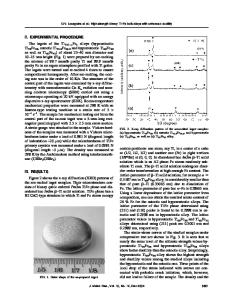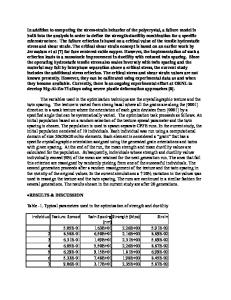Enhanced strength and ductility of a tungsten-doped CoCrNi medium-entropy alloy
- PDF / 678,887 Bytes
- 9 Pages / 584.957 x 782.986 pts Page_size
- 28 Downloads / 224 Views
ARTICLE Enhanced strength and ductility of a tungsten-doped CoCrNi medium-entropy alloy Zhenggang Wuc) Materials Science & Technology Division, Oak Ridge National Laboratory, Oak Ridge, Tennessee 37831, USA
Wei Guoc) Center for Nanophase Materials Sciences, Oak Ridge National Laboratory, Oak Ridge, Tennessee 37831, USA
Ke Jinc) Materials Science & Technology Division, Oak Ridge National Laboratory, Oak Ridge, Tennessee 37831, USA
Jonathan D. Poplawsky Center for Nanophase Materials Sciences, Oak Ridge National Laboratory, Oak Ridge, Tennessee 37831, USA
Yanfei Gaoa) Materials Science & Technology Division, Oak Ridge National Laboratory, Oak Ridge, Tennessee 37831, USA; and Department of Materials Science & Engineering, University of Tennessee, Knoxville, Tennessee 37996, USA
Hongbin Beib) Materials Science & Technology Division, Oak Ridge National Laboratory, Oak Ridge, Tennessee 37831, USA (Received 20 April 2018; accepted 28 June 2018)
Developing metallic materials with a good combination of strength and ductility has been an unending pursuit of materials scientists. The emergence of high/medium-entropy alloys (HEA/MEA) provided a novel strategy to achieve this. Here, we further strengthened a strongand-ductile MEA using a traditional solid solution strengthening theory. The selection of solute elements was assisted by mechanical property and microstructure predictive models. Extensive microstructural characterizations and mechanical tests were performed to verify the models and to understand the mechanical behavior and deformation mechanisms of the designated CoCrNi–3W alloy. Our results show good experiment-model agreement. The incorporation of 3 at.% W into the ternary CoCrNi matrix increased its intrinsic strength by ;20%. External strengthening through microstructural refinement led to a yield strength nearly double that of the parent alloy, CoCrNi. The increase in strength is obtained with still good ductility when tested down to 77 K. Nanoscale twin boundaries are observed in the post-fracture microstructure under 77 K. The combination of strength and ductility after W additions deviate from the traditional strength-ductility-trade-off contour.
I. INTRODUCTION
Increasing the strength of metallic alloys is an unending pursuit for people, and continuous efforts have been made to cater the increasing requirement for loadbearing applications under various conditions. Pure metals without additional alloying elements typically exhibit low strength and thus are rarely used. During alloying development, a few strengthening mechanisms were proposed, including strain hardening, precipitation strengthening, grain size refinement strengthening, interface/grain boundary strengthening, and solid solution strengthening (SSS).
Address all correspondence to these authors. a) e-mail: [email protected] b) e-mail: [email protected] or [email protected] c) These authors contributed equally to this work. DOI: 10.1557/jmr.2018.247 J. Mater. Res., 2018
Among the multiple strengthening approaches, the SSS introduces foreign atoms (sol
Data Loading...











